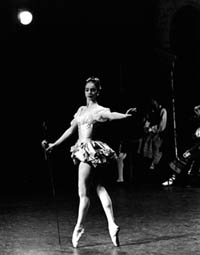
en Don Quijote
Suzanne Farrell (1945)
Ballerina Extraordinaire As a child, Roberta Sue Ficker of Cincinnati, Ohio never dreamed of becoming Suzanne Farrell, the youngest ballerina in the history of the New York City Ballet. A devotee of tree climbing, dodgeball and playing "dress-up," she imagined instead that she would work as a clown. Her study of dance began at age eight when it was decided ballet classes might make the little "tomboy" more ladylike.
Her passion for the art was not instantaneous. Tall for her age, she played boys' roles in school recitals, and preferred tap and acrobatics to ballet, but finally graduated to a tutu at age 12. After her parents divorced in 1954, her mother worked as a nurse to support her three girls, who were constantly practicing and rehearsing at the Cincinnati Conservatory of Music.
In 1959 Diana Adams, star dancer of the New York City Ballet and discovery of choreographer George Balanchine, toured the country scouting talent for the School of American Ballet. Young Suzanne was selected to audition for the legendary Balanchine. After winning a Ford Foundation Scholarship to attend the School, she relocated with her mother and sister to a one-room apartment on New York's Upper West Side.
She began by performing an "angel" role in The Nutcracker along with the other students. At the beginning of the 1961-62 season she joined the corps de ballet of the company. By that summer, she was dancing featured roles. Choreographer John Taras was the first to create a role especially for Farrell in Arcade, which premiered in 1963 with music by Igor Stravinsky. Several weeks later, she danced the lead role in a new Balanchine/Stravinsky collaboration, Movements for Piano and Orchestra. She also danced leading roles in Agon, Orpheus, and Liebeslieder Walzer.
Reviewers began to take notice not only of her long, slender body and impeccable technique, typical of the Balanchine-trained dancer, but of her special personal lyricism and spontaneity.
In 1965 Balanchine choreographed a new full-length ballet on the theme of Don Quixote, to a new score by his fellow Russian exile Nicholas Nabokov. Farrell's performance of Dulcinea, the idealized dream woman of the addled knight made her a star. The choreographer had created the role especially to take advantage of her magical, mysterious qualities. He was often quoted in the press as saying of his youthful protege, "She is my muse." Don Quixote is considered by Ms. Farrell as her breakthrough ballet in terms of pure emotional honesty on stage. This stunning production sealed the unique bond between the young artist and her inspired mentor "Mr. B."
In 1965, before European and Middle Eastern tours, Ms. Farrell was promoted to principal dancer. In 1966, she undertook her first leading role from the classical repertoire, the Swan Queen in Tchaikovsky's Swan Lake. This was a version in which Balanchine combined modern inventions of his own with the traditional staging he had learned at the Russian imperial ballet school as a young man in St. Petersburg.
Critics now praised her growing maturity especially in her signature role in Don Quixote. Between seasons, she taught at the University of Cincinnati. In 1967 the NYCB version of A Midsummer Night's Dream was filmed by Columbia Pictures.
When Farrell married Paul Mejia, another young dancer in the company, relations with Balanchine became strained, and the newlyweds left the New York City Ballet. Ms. Farrell began a second career at Ballet of the 20th Century, the Brussels-based company of the controversial Belgian choreographer Maurice Bejart. Bejart's lavishly designed, theatrical works were the polar opposite of Balanchine's cool, abstract, contemplative approach. The first collaboration was in 1970, a pas de deux entitled Bach Sonate It was followed by many others, including Romeo and Juliet, Fleurs du Mal, Rite of Spring, Bolero, and their two most successful projects, Nijinsky, Clown of God and Le Triomphe.
In time, Farrell returned to the New York City Ballet. She and Balanchine collaborated on Chaconne, Vienna Waltzes, Union Jack, Tzigane, Davidsbundlertanze, and his final masterpiece, Mozartiana, The last two ballets Balanchine choreographed were solos for Farrell, ten months before he died in April, 1983.
In 1983, while on a European tour for the Chicago City Ballet, Suzanne Farrell began to experience intense pain in her right hip. Suspecting a pulled muscle, she continued to dance, but her hip grew steadily worse. Unprepared for the professional diagnosis she finally sought, she could not bring herself to speak the doctors' word, "arthritis." Two years later, by the age of 40, she had tried every treatment available, without improvement. Though physically compromised and often in pain, she continued performing for four years. She experienced more difficulty in walking than in dancing -- perhaps a miracle for those moments -- but her condition deteriorated, necessitating hip replacement surgery.
Ms. Farrell retired from the stage in 1989. She has since traveled the world teaching Balanchine ballets to a new generation of dancers and repaying her debt to the man who made her one of the brightest stars of the international dance scene. Currently, she is the repetiteur for the Balanchine Trust, an independent organization founded to oversee the licensing and staging of his ballets. Other troupes she has worked with include the Kirov Ballet, the Royal Danish Ballet, the Paris Opera Ballet, the Bolshoi Ballet and many American companies.

en Don Quijote



